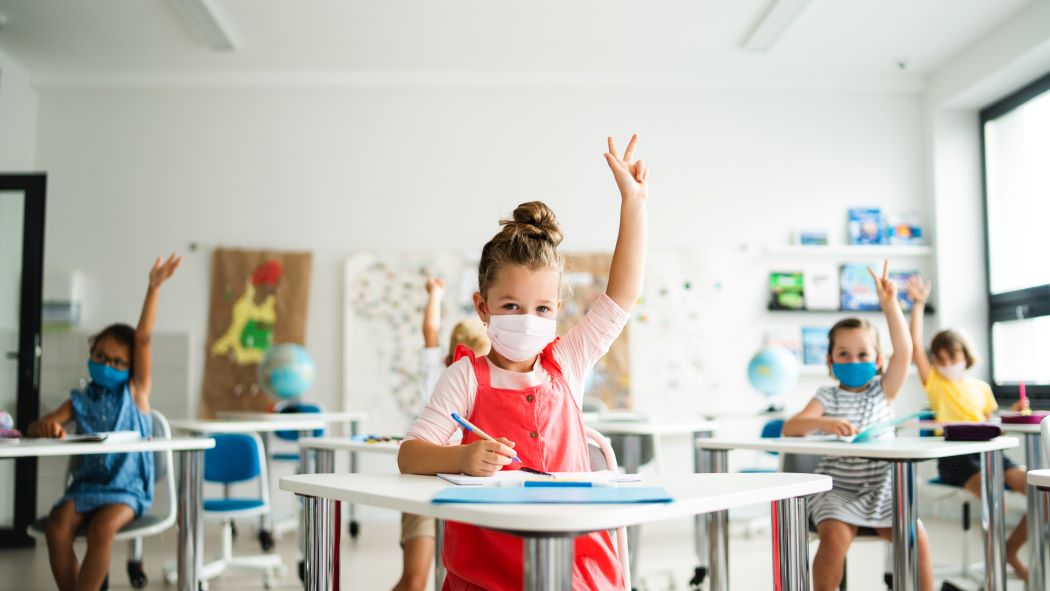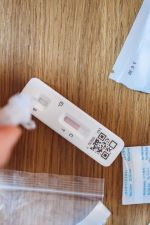As the COVID-19 pandemic continues to evolve, parents might feel like they’re scrambling to keep up with the best ways to safeguard their children. We asked Dr. Steve Miller, Cigna clinical advisor, for his latest guidance based on parents’ most common questions.

As the COVID-19 pandemic continues to evolve, parents might feel like they’re scrambling to keep up with the best ways to safeguard their children. We asked Dr. Steve Miller, Cigna clinical advisor, for his latest guidance based on parents’ most common questions.
What is the best mask for kids?
The more we learn about how omicron is transmitted, the more we believe that basic cloth masks won’t offer the level of protection needed for children, especially if they are not vaccinated. Instead, look for three-ply surgical masks with an adjustable nose or KN95 masks. If those are too uncomfortable for your child, consider using double cloth masks.
When masking, fit is the most important factor. To check, have your child put on the mask and then put on glasses or sunglasses. If they can feel air escaping or the glasses fog up, the mask is not a good fit.
Is there a maximum amount of time that kids can safely wear a mask?
There’s no maximum time, but masks can get wet or dirty throughout the day. Consider packing an extra mask if you have one available so your child can swap it out.
Can I wash KN95 masks? How often can we reuse them?
KN95s should not be washed, but they can be reused. If possible, keep three masks in rotation at a time. Between uses, place them in paper bag for 24 to 48 hours, which will allow the time needed to essentially sanitize them.
Masks should be discarded when they are soiled or no longer seal properly. In addition, the Centers for Disease Control (CDC) recommends that you should not use a mask more than five times.
What’s the most up-to-date COVID vaccine guidance for different ages of children?
The Pfizer vaccine has been approved for children ages 5 and older, but vaccination rates are still relatively low for this age group. If you have children 5 and older who are not vaccinated, do it now.
Children 12 to 17 should get a booster shot five months after their second shot, and immunocompromised children 5 and older should get an additional dose 28 days after their second shot.
Also, don’t delay early immunizations (outside of COVID vaccines). If you have concerns, call your pediatrician and discuss the precautions they are taking to keep children safe.
My daycare-age kids are too young to articulate how they’re feeling, and they often have a runny nose or a cough. What should I do if I think my child has COVID?
It’s important to watch for fever, shortness of breath, and listlessness. If your children don’t exhibit any of these symptoms or don’t otherwise seem ill, you don’t need to worry. However, don’t hesitate to consult your pediatrician if you have any concerns.
If I need to get my kids tested for COVID, where should I take them?
Call your pediatrician or doctor for advice or contact your local health department. They can direct you to the best place for testing and treatment in your area or recommend over-the-counter tests for children.
If we need a PCR test, is it dangerous to take my kids to urgent care because of the risk of being exposed to COVID? Is the pediatrician a better option?
Depending on community spread in your area, if children are too young to be vaccinated, you can minimize risk by taking them to an alternative site, such as a drive-through testing location or a pharmacy.
Even if they are vaccinated, double mask or use a three-ply surgical mask with adjustable nose or a KN95 mask.
If my child has COVID and is too young to isolate, how does my family manage? Should everyone wear masks around that child? Should one parent isolate with the child?
When a child has been diagnosed with COVID, you should designate a fully vaccinated family member to be the primary caregiver. Anyone who comes into contact with the child should mask at all times.
In addition, the CDC recommends:
- Everyone in the household should test three days after exposure. Until getting a negative result, they should wear masks in and out of the house.
- Have everyone in the house wash their hands at every opportunity. Clean and disinfect all commonly shared surfaces – and don't forget the refrigerator and microwave handles.
- When eating, the child with COVID should not be in the room. No one should share drinking glasses, cups, forks, or other eating utensils. In addition, don’t share towels or bedding.
- Dedicate a lined trash can for any tissues or other paper or disposable products used by an isolated or sick person.
- Wear disposable gloves when cleaning the child's bedroom or bath, and discard the gloves before moving on to other cleaning chores. Wash your hands after removing the gloves.
- When cleaning, take care not to shake the isolated child's dirty clothes. This will minimize the possibility of dispersing the virus through the air.
If I test positive for COVID but need to take care of my kids, what precautions should I take? Or should I assume they were exposed before I knew I was sick?
Because your kids are considered a close contact, you should follow the public health guidance outlined above to isolate and limit transmission.
Does the answer to the above question about precautions change if my kids are healthy and don’t have underlying health conditions?
No.
Some parents are saying that if a young child gets COVID-19, it’s best for the rest of the family to get sick too (and get it over with). What are your views on that?
This is not a great idea. It’s similar to the approach taken with chicken pox years ago, and people ended up dying after being intentionally exposed. Deliberate exposure also will make you a potential transmitter of the virus to others, even if you don’t show any symptoms.
It’s important to remember that despite the milder symptoms many are experiencing with the omicron variant, COVID is not a cold. While most people are tolerating it well, those who are over 65, immune suppressed, or have other risk factors are having a very difficult course, as evidenced by overflowing hospitals. In addition, long COVID symptoms have been quite debilitating for many people.
My kids go to different schools, which have different rules about quarantining, masking, etc. How should I handle this confusing situation? How can I keep my kids safe at school during the COVID pandemic?
Transparency and communication is key between families, schools, and work to minimize disruption and ensure everyone is in lockstep for different scenarios.
To prepare for contingencies as much as you can and develop a system that works for you, consider taking these steps:
- Set up a structure so potential caregivers understand roles and expectations in the event a child is sent home.
- Prepare list of emergency phone numbers, including health care providers, the health department, your preferred hospital, and preferred ambulatory service, just in case you need them.
- If you are working, maintain transparency and communication with your employer on what’s going on and prepare a plan for coverage should one of your children be sent home.
Masking in general is recommended, even if the school does not require it. Do your best to make sure your child wears a mask while at school.
In addition, remember that COVID is not the only respiratory illness we’re seeing this winter. Others are circulating. If your children are symptomatic for anything, the best decision is to keep them home and monitor them.
School rules are changing constantly. How do I know I’m doing the right thing for my family?
It’s important to remember that the guidance is changing because we are learning more about COVID. We do know that when used together, vaccination, masking, and test-to-stay strategies will help minimize transmission.
Understand the precautions that schools and childcare centers are taking. Discuss your specific situation with your pediatrician and your own health care provider, including your child's health, the prevalence of the virus in your community, and whether you have been or might have been exposed. Together, you and your providers can make the best decision for your family.
If your child is obese, has diabetes or asthma, is immunosuppressed, or is otherwise at high risk, virtual schooling may be the right decision, especially if community transmission is high in your area.

The 411 on At-Home COVID-19 Tests
In addition to issues accessing tests, the accuracy of home tests is often questioned – along with how to select the best tests, how to use them, and when to use them. In this article, we answer some of the most common questions about at-home testing and more.